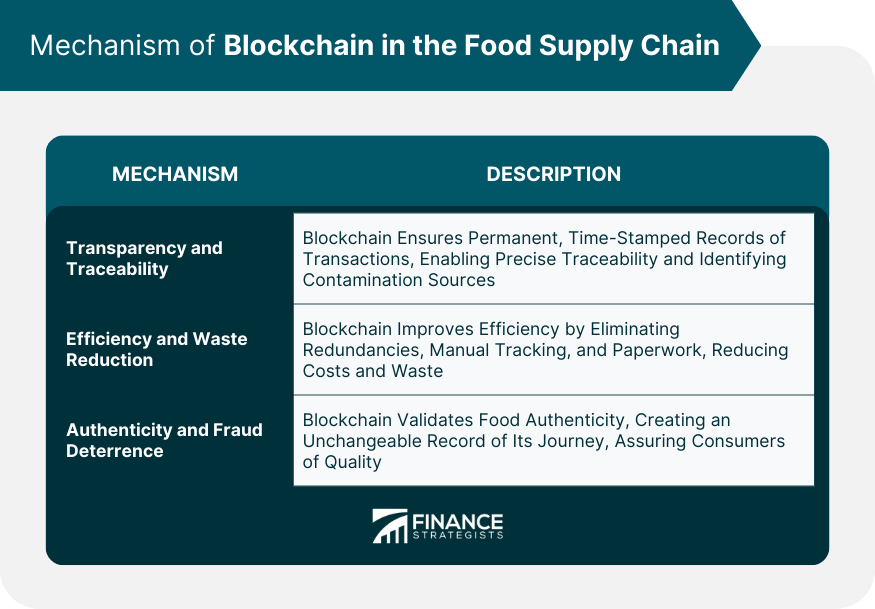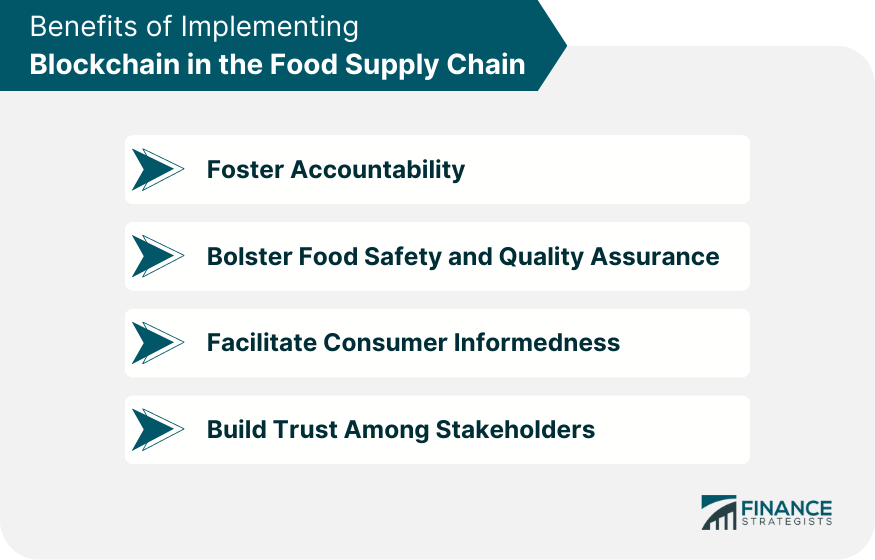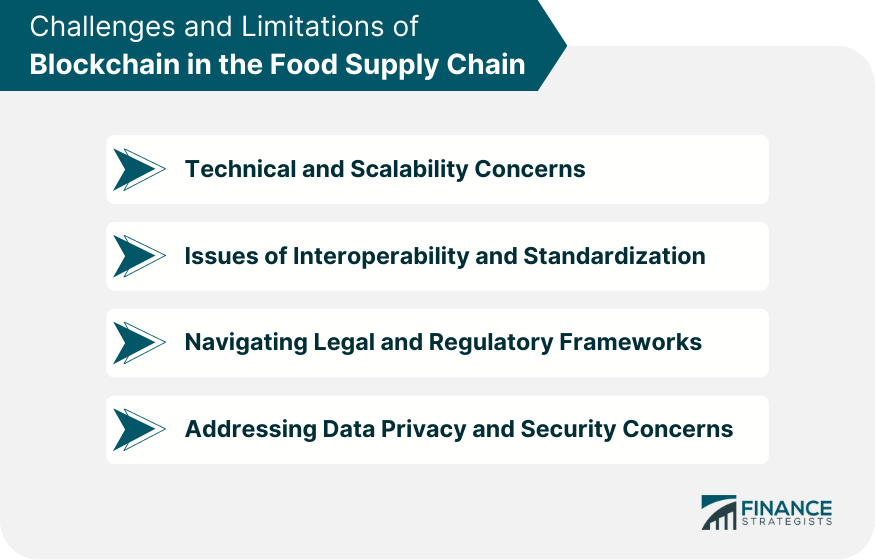Blockchain technology, originally devised for the digital currency Bitcoin, is now finding applications in a wide array of industries, including the food supply chain. Blockchain, essentially, is a type of distributed ledger technology that allows data to be stored globally on thousands of servers. In the context of the food supply chain, it helps record transactions, track assets, and create transparency, enabling stakeholders to view transaction history in an open, decentralized network of participants. The purpose of integrating blockchain into the food supply chain is to bolster transparency, efficiency, and authenticity. With escalating consumer demand for food safety and transparency, the traditional methods of tracing food from farm to table have shown their limitations. Blockchain can address these gaps by providing a platform that enables a secure, accessible digital version of every transaction or interaction, including processes such as cultivation, harvest, processing, packaging, and distribution. One of the key mechanisms by which blockchain transforms the food supply chain is through enhanced transparency and traceability. The unalterable, time-stamped records ensure that every transaction or event along the supply chain is permanently documented. This allows for precise traceability of every food item, helping identify sources of contamination or substandard products swiftly and accurately. Blockchain can help optimize the food supply chain by eliminating redundancies, improving logistical efficiency, and reducing waste. By providing real-time access to information, it eliminates the need for manual tracking, paperwork, and administrative processes. This leads to substantial cost savings and waste reduction, as products can be traced back to their origin quickly, minimizing the need for mass recalls in the event of a food safety issue. Blockchain can help validate the authenticity of food products, thereby deterring food fraud, which is a major concern in the food industry. By creating an immutable record of a product's journey from farm to table, it provides assurance to consumers about the authenticity and quality of the food they consume. Several notable implementations and projects have been undertaken to explore the potential of blockchain in the food industry: IBM Food Trust is a blockchain-based platform that enables end-to-end traceability of food products. It allows participants across the supply chain, including farmers, processors, distributors, and retailers, to share and access trusted information about the origin and journey of food products. Walmart has conducted several blockchain pilot projects to improve food traceability. For example, they partnered with IBM and other companies to trace the journey of mangoes, pork, and other products, reducing the time taken to track the source of contamination from weeks to seconds. Carrefour, a multinational retail corporation, has implemented blockchain technology to enhance the traceability of products such as chicken, eggs, and milk. Through the use of QR codes, consumers can access information about the product's origin, farming practices, and quality certifications. Various other companies and organizations have explored the potential of blockchain in the food supply chain. Examples include the use of blockchain to trace tuna in the Pacific by the World Wildlife Fund (WWF) and the partnership between Nestlé, Carrefour, and IBM to track baby milk formulas. Implementing blockchain in the food supply chain fosters greater accountability among all stakeholders. It ensures that all actors in the chain are held accountable for their actions because any non-compliance can be traced back to its source. This helps build a more responsible and sustainable food system. Blockchain technology has the potential to greatly enhance food safety and quality assurance by creating a single, unchangeable record of a food product's history. By providing stakeholders with real-time access to this data, it helps detect issues faster, reducing the risk of foodborne illnesses and maintaining consumer trust. In an era where consumers increasingly want to know where their food comes from, blockchain technology can provide transparency like never before. Through blockchain, consumers can have access to information about the source of their food, how it was produced, and how it got to them, thereby facilitating informed choices. By creating an immutable record of all transactions and interactions, blockchain builds trust among stakeholders in the food supply chain. It ensures that everyone has the same information, fostering an environment of trust and collaboration. Despite the potential benefits, the implementation of blockchain in the food supply chain is not without challenges. Technical issues, such as the need for high computational power and the difficulty of scaling the technology, can be significant obstacles. Another challenge lies in the issues of interoperability and standardization. Currently, there is a lack of standardized protocols for the use of blockchain in the food supply chain, which hampers interoperability among different systems. This results in isolated blockchain systems that cannot interact with each other, limiting the potential benefits of the technology. Legal and regulatory frameworks are another challenge. Regulations regarding data privacy, food safety, and traceability vary greatly worldwide, creating a complex environment for the implementation of blockchain in the food supply chain. Companies need to ensure that their use of blockchain complies with all relevant laws and regulations, which can be a significant challenge. Finally, data privacy and security are major concerns. Although blockchain technology is inherently secure, the data it records is only as reliable as the information inputted. There are also concerns about how to ensure the privacy of sensitive data in a transparent system. The potential of blockchain technology in the food supply chain is vast, offering numerous benefits such as improved transparency, greater efficiency, and enhanced authenticity. However, significant challenges such as technical issues, lack of standardization, complex legal environments, and data privacy concerns pose hurdles to widespread adoption. While blockchain may not be a panacea for all the issues in the food supply chain, it represents a powerful tool that can substantially improve food traceability and safety. By addressing these challenges, the industry can leverage blockchain technology to its full potential, creating a more transparent, efficient, and sustainable food supply chain.What Is Blockchain in the Food Supply Chain?
Mechanism of Blockchain in the Food Supply Chain
Ensure Transparency and Traceability
Promote Efficiency and Reducing Waste
Validate Authenticity and Deterring Fraud

Implementations of Blockchain in the Food Supply Chain
IBM Food Trust
Walmart's Blockchain Pilot Projects
Carrefour’s Blockchain-Based Traceability System
Other Notable Blockchain Initiatives in the Food Industry
Benefits of Implementing Blockchain in the Food Supply Chain
Foster Accountability
Bolster Food Safety and Quality Assurance
Facilitate Consumer Informedness
Build Trust Among Stakeholders

Challenges and Limitations of Blockchain in the Food Supply Chain
Technical and Scalability Concerns
Issues of Interoperability and Standardization
Navigating Legal and Regulatory Frameworks
Addressing Data Privacy and Security Concerns

Bottom Line
Blockchain in the Food Supply Chain FAQs
Blockchain technology in the food supply chain is a system that tracks and records transactions at every stage of the supply chain, from production to consumption, creating a digital, unalterable ledger. This offers enhanced transparency, authenticity, and efficiency in the food supply chain.
Blockchain records every transaction and event in a secure, time-stamped, and unchangeable way. This allows for every food item to be traced back to its origin, improving transparency and making it easier to identify the sources of contamination or substandard products.
Blockchain fosters greater accountability, bolsters food safety and quality assurance, facilitates consumer informedness, and builds trust among stakeholders. Creating an unchangeable record of a food product's history helps detect issues faster and maintains consumer trust.
The implementation of blockchain in the food supply chain faces challenges like technical and scalability issues, lack of standardization and interoperability, complex legal and regulatory frameworks, and data privacy and security concerns.
Yes, blockchain can significantly deter food fraud. It creates a verifiable and immutable record of a product's journey from farm to table, providing assurance to consumers about the authenticity and quality of their food.
True Tamplin is a published author, public speaker, CEO of UpDigital, and founder of Finance Strategists.
True is a Certified Educator in Personal Finance (CEPF®), author of The Handy Financial Ratios Guide, a member of the Society for Advancing Business Editing and Writing, contributes to his financial education site, Finance Strategists, and has spoken to various financial communities such as the CFA Institute, as well as university students like his Alma mater, Biola University, where he received a bachelor of science in business and data analytics.
To learn more about True, visit his personal website or view his author profiles on Amazon, Nasdaq and Forbes.











